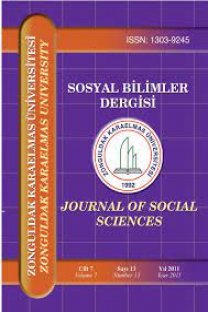Predicting the Trend and Seasonal Factors of Total Suspended Particles (TSP) Levels in Trabzon: Seasonal and Weighted Least Squares Regression
Türkiye’nin Doğu Karadeniz Bölgesinde yer alan Trabzon’da kış mevsiminde hava kirliliği en önemli çevre sorunlarından birisidir. Uzun zamandan beri rutubetli iklimin yanında yoğun kentleşme çok önemli çevre sorunlarına neden olmaktadır. Hava kalite yönetiminin temel hedeflerinden birisi de herhangi bir bölgedeki hava kalitesi üzerinde etkili olan trend veya mevsimsellik gibi faktörleri tahmin etmektir. Bu çalışmada Trabzon’da toplam asılı partiküller maddede düzeylerindeki trend ve mevsimlik faktörler en uygun ve güvenilir tekniklerle araştırılmaktadır. Araştırmada Ocak 1996 ile Haziran 2007 tarihleri arasındaki aylık asılı partiküller serisi kullanılmaktadır. Ağırlıklı regresyon analizi ile elde edilen en uygun sonuçlarda düzeltilmiş-R2 değerinin %83,8 ve toplam asılı partiküller düzeylerinin Ocak 1996-Haziran 2007 döneminde yıllık trendinin pozitif ve yaklaşık olara 0,08 um/m3 olduğu ve bunun 0,681 anlamlılık düzeyine sahip olduğu anlaşılmaktadır.
Trabzon'da Toplam Asılı Partiküller Düzeylerindeki Trendin ve Mevsimlik Faktörlerin Tahmin Edilmesi: Mevsimsel ve Ağırlıklı Regresyon Analizi
In winter season the air pollution is the one of the most important environmental problems in Trabzon, located in Eastern Black Sea Region of Turkey. The humid climate as well as the densely populated urbanization cause serious problems for a long time period. One of the main targets of air quality management is to estimate the influence of different factors such as trend and seasonality upon air quality levels in a given area. In this paper, an attempt has been made to identify and estimate the trend and seasonal factors in TSP in Trabzon using accurate and reliable techniques. The data used in this study is concerned with monthly measurement levels of TSP taken from January 1996 through May 2007. The most accurate WLS regression results show that the adjusted–R2 is about 83,8% and the monthly averages of TSP do not have a clear trend over the period 1996–2007, the trend estimate is only about 0,08 points per year, which has a statistical significant of 0,681.
___
- Aneja, V. P., A. Agarwal, P. A. Roelle, S. B. Phillips, Tong, Q. Watkins (2001), “Measurements and Analysis of Criteria Pollutants in New Delhi”, India, Environmental International, 27, 35–42.
- Chapman, R. S., W. P. Watkinson, K. L. Dreher and D. L. Costa (1997), “Ambient Particulate Matter and Respiratory and Cardiovascular İllness in Adults: Particle-Borne Transition Metals and The Heart–Lung Axis”, Environmental Toxicology and Pharmacology, 4, 331–338.
- European Council (1999), Air Quality Daumhter Directive 1999/30/CE.
- Goswami, E., T. Larson, T. Lumley and L. Lieu (2002), “Spatial Characteristics of Fine Particulate Matter İdentifying Representative Monitoring Locations in Seattle, Washington”, Journal of Air and Waste Management Association, 52, 324–333.
- Gömer, D., F. Somunkıranoğlu and E. Tok (2006), “Introduction into the Twinning Project Air Quality of The European Commission”, City and Health Symposium, Bursa: Uludağ University.
- Gujarati, D. N. (1995), Basic Econometrics (Third Edition), McGraw-Hill, New Jersey.
- Gupta, I. and R. Kumar (2006), “Trends of Particulate Matter in Four Cities in India”, Atmospheric Environment, 40, 2552–2566.
- Harrison, R. and J. Yin (2000), “Particulate Matter in the Atmosphere: Which Particle Properties are Important for its Effect on Health”, The Science of the Total Environment, 249, 85-101.
- Hess, A., H. Iyer and M. Willium (2001), “Linear Trend Analysis a Comparison of Methods”, Atmospheric Environment, 35, 5211–5222.
- Hintze, J. L. and NCSS (2005), User's Guide-II: Regression and Curve Fitting, NCSS Inc., Kaysville.
- Hintze, J. L. and NCSS (2005), User's Guide-IV: Multivariate Analysis, Clustering, Meta Analysis, Forcasting, Time Series, Operation Research and Mass Appraisal, NCSS Inc., Kaysville.
- Jorquera, H., W. Palma and J. Tapia (2000), “An Intervention Analysis of Air Quality Data at Santiago Chile”, Atmospheric Environment, 34, 4073–4084.
- Mage, D., G. Ozolins, P. Peterson, A. Webster, R. Ortherfer, V. Vandeveerd (1996), “Urban Air Pollution in Megacities of the World”, Atmospheric Environment, 30, 681–686.
- Makridakis, S. and Wheelwright (1978), Iterative Forecasting, Holden-Day, California.
- Mayer, H. (1999), “Air Pollution in Cities”, Atmospheric Environment , 4029-4037.
- Müller, W. J. (2006), “Exceeding of EU-Air Quality Limit Values Starts Clean Air Planning Examples From Germany and Europe”, City and Health Symposium, Bursa: Uludağ University.
- Norusis, M. J. and SPSS Inc (1999), SPSS Regression Models 10.0, SPSS Inc., Chicago.
- Orhunbilge, N. (1998), Zaman Serileri Analizi ve Tahmin Yöntemleri, Avcıol-Basım Yayın, İstanbul.
- Pope III., C., M. Thun, M. Namboodiri, D. Dockery, J. Evans, F. Speizer (1995), “Particulate Air Pollution is a Predictor of Mortality in a Prospective Study of US Adults”, Am. J.Respir. Crit. Care Med., 669–674.
- Sapan, N. (2006), “Effects of Air Pollution On Child Health”, City and Health Symposium, Uludağ University, Bursa.
- Shin, K. (1996), SPSS Guide for DOS Version 5 and Windows Versions 6 and 6.1.2, Irwin, Chicago.
- Turanlıoğlu, F. S., A. Nuhoğlu and H. Bayraktar (2005), “Impacts of Some Meteorological Parameters on SO2 and TSP Concentrations in Erzurum,Turkey”, Chemosphere, 59, 1633-1642.
- Vardoulakis, S. and P. Kassomenos (2008), “Sources and Factors Affecting PM10 Levels in two European Cities: Implication for Local Air Quality Management”, Atmospheric Enviroment, 42, 17, 58-67.
- ISSN: 1303-9245
- Yayın Aralığı: Yıllık
- Başlangıç: 2018
- Yayıncı: -
Sayıdaki Diğer Makaleler
Bilgi Yönetimi Uygulamasında Etkili Olan Faktörler Üzerine Mobilyacılık Sektöründe Bir Araştırma
Civilization and Universal History in Conceptualizing Globalization
Causal Relationship Between electricity Consumption and Economic Growth in Turkey
Anlatı Mesafesi- Anlatı Perspektifi Kavramları, Sinematografik Anlatı ve Örnek Çözümlemeler
Turhan KORKMAZ, Selin ZAMAN, Emrah İ. ÇEVİK
The Regulation of Large Retail Firms in Turkey: A Game Theory Based Analytical Model
